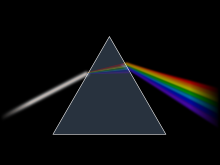
Rainbow gravity (or "gravity's rainbow"[1]) is a theory that different wavelengths of light experience different gravity levels and are separated in the same way that a prism splits white light into the rainbow.[2] This phenomenon would be imperceptible in areas of relatively low gravity, such as Earth, but would be significant in areas of extremely high gravity, such as a black hole. As such the theory claims to disprove that the universe has a beginning or Big Bang, as the big bang theory calls for all wavelengths of light to be impacted by gravity to the same extent.[3] The theory was first proposed in 2003 by physicists Lee Smolin and João Magueijo, and claims to bridge the gap between general relativity and quantum mechanics.[3] Scientists are currently attempting to detect rainbow gravity using the Large Hadron Collider.[4]
- ^ Cite error: The named reference
physwas invoked but never defined (see the help page). - ^ Cite error: The named reference
PBSwas invoked but never defined (see the help page). - ^ a b Cite error: The named reference
SciAmwas invoked but never defined (see the help page). - ^ Cite error: The named reference
Telegraphwas invoked but never defined (see the help page).